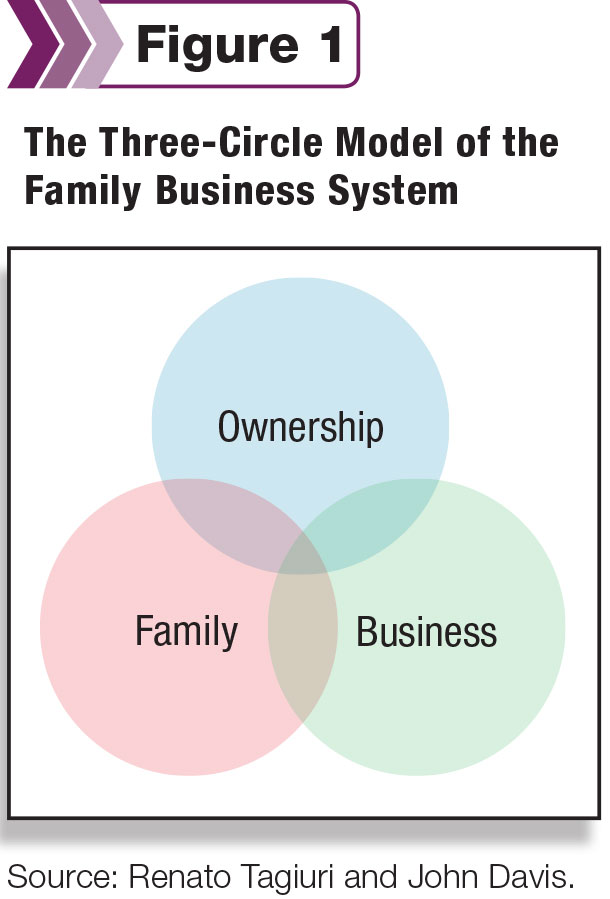A healthy owning family with strong values may be the greatest resource a business can have. —Aronoff, C., & Ward, J. (2011). Family meetings: How to build a stronger family and a stronger business. New York, New York: Palgrave Macmillan.
“Family governance”… the term seems a little fancy, a little formal. Maybe an activity for a bigger business, a more complicated family. Family governance would certainly only be for businesses already owned by multiple generations. Right?
In fact, family governance can actually be simple, informal and built side by side with the growth of your business and your family.
The Three-Circle Model of the Family Business System (Figure 1) was developed at Harvard Business School in 1982 and continues to be the central organizing framework for understanding family business systems.

The diagram represents three interdependent and overlapping systems in a family enterprise: family, ownership and business.
For a family business to function effectively over time, each system must understand how to interact with and support the other systems. In addition, people within each system should appreciate which decisions are theirs to make. This interaction, support and decision-making is governance.
As your family business organization grows, the business and ownership systems evolve and professionalize. Within the business system, middle managers are hired, a meeting structure that fosters communication across more business units and bigger teams develops, and non-family managers contribute more and more to the business.
To govern the ownership system, a functional board emerges: first consisting of family owners working within the business, next non-managing family are added, and then independent directors are recruited.
Less common is the growth and deliberate formalization of the family system – or the development of family governance. Family governance is the structure utilized to educate and facilitate communication between family members.
It provides a forum for constructive discussion, problem-solving and decisions about the family as it relates to the business as well as how the business relates to the family.
Why does the structure that supports the family system often come last? In agricultural businesses, where independence is prized, formally convening the family often feels like we’re inviting perspectives from a diverse and (sometimes) uneducated stakeholder group.
“It’s hard enough to get decisions made among my two brothers and me. And you’re suggesting I should have another meeting and ask for my family’s input, too? Are we going to let them have a say in how the business runs?”
That’s the response of many business leaders to whom I’ve suggested the time is right for a family meeting. A family meeting does not mean the management and leadership of the business will be turned into a democracy – or that family members automatically get their way.
Another challenge is the foreign-ness and formality of a family meeting. When “everyone” works in the business and sees each other every day, why is an official meeting required? Additionally, some folks balk at sharing business information; they are intensely private and don’t see the need to share challenges or wins with anyone, even family.
Fortunately, as I mentioned above, family governance can be quite simple. It doesn’t require frequent meetings, disclosing your entire balance sheet or allowing your 12-year-old snowboarding enthusiast to have input on your milk marketing program.
Family governance, despite the term’s fanciness, can simply begin with a family meeting. And the impact of family governance is long-lasting, including stronger family relationships that form a foundation of support for the family business.
In fact, family governance is a bit like a vaccination; it helps protect your family from exposure to the “diseases” of conflict, hurt feelings and miscommunication that happen within every family business.
Below are some practices that can increase the probability of holding a family meeting that grows and nurtures that family foundation.
1. Match the formality, length and agenda to the stage of the family.
- If the next-generation children are under 12, keep the meetings to 15 to 30 minutes and emphasize collaboration, shared responsibility and conflict resolution. These meetings often take place as a nuclear family.
- As children reach teenage years, meetings should include successors from all family branches. Topics can include updates about the business – talking about both the rewards and responsibilities that go with ownership.
- As children reach their 20s, the family can begin to do some work, including developing a family employment policy and updating or discovering family values.
- Within the agenda, consider the following proportions:
-
One-third family development – Talking about the family and business history, learning about different facets of the business and building specific skills
-
One-third family business information – Meeting family executives and employees, talking about business plans, opportunities and challenges, taking tours
- One-third fun – Games, activities and team-building exercises
2. Consider having someone who doesn’t work in the business facilitate the meeting.
- Facilitation includes communicating the location, time and agenda, ensuring a variety of family members speak up and ensuring the meeting stays on time.
- A family business meeting is an opportunity for someone who does not have a management role within the business to take on a leadership role.
- When the meetings start to get more formal (a larger group with successors in their 20s), it can sometimes help to hire a non-family facilitator.
3. Think carefully about who is invited.
- As successors begin to marry and start their own families, will those in-laws be invited? If the meeting has been called to handle a conflict or sensitive issue, sometimes in-laws are not invited.
However, as the family settles into “regular” meetings, most families do include in-laws within family meetings. To build that family foundation, it’s helpful to have both parents of future generations understand the business values and history.
4. Address confidentiality expectations right up-front.
- As the meeting gets started and the purpose and agenda are shared, also review some ground rules about acceptable behaviors, especially confidentiality.
- Go through some scenarios about how, without meaning to, folks might break confidentiality. This will help minimize the chance of attendees inadvertently spilling family secrets.
Regular family meetings are one of the three practices that contribute to the longevity of family-owned businesses. Holding them may make you feel a bit vulnerable.
Getting them kicked off may feel a bit awkward. Going into this year of challenging economics, this kind of new practice may feel like one more responsibility that you don’t have time for.
But in under six hours a year, you can create energy and shared leadership that will help your business weather these kinds of rough times. And that will bring even more joy during the great times. PD
Barb Dartt is a family business consultant with 16 years’ experience supporting folks in business with family. Email Barb Dartt. For more information on this topic, check out the book referenced in the lead-off quote – Family Meetings: How to build a stronger family and a stronger business, by Craig Aronoff and John Ward.






